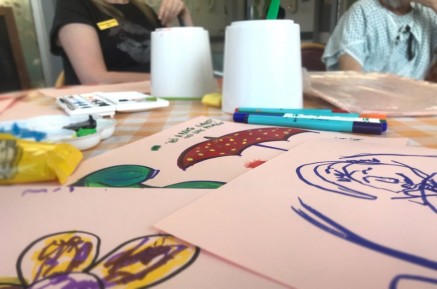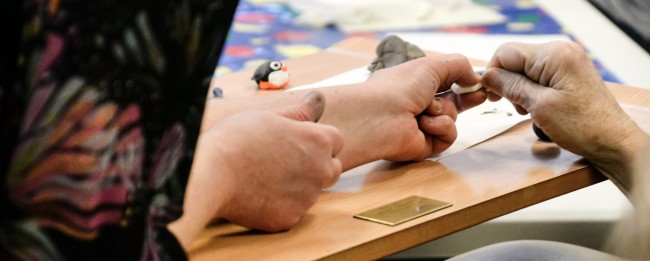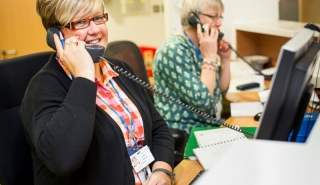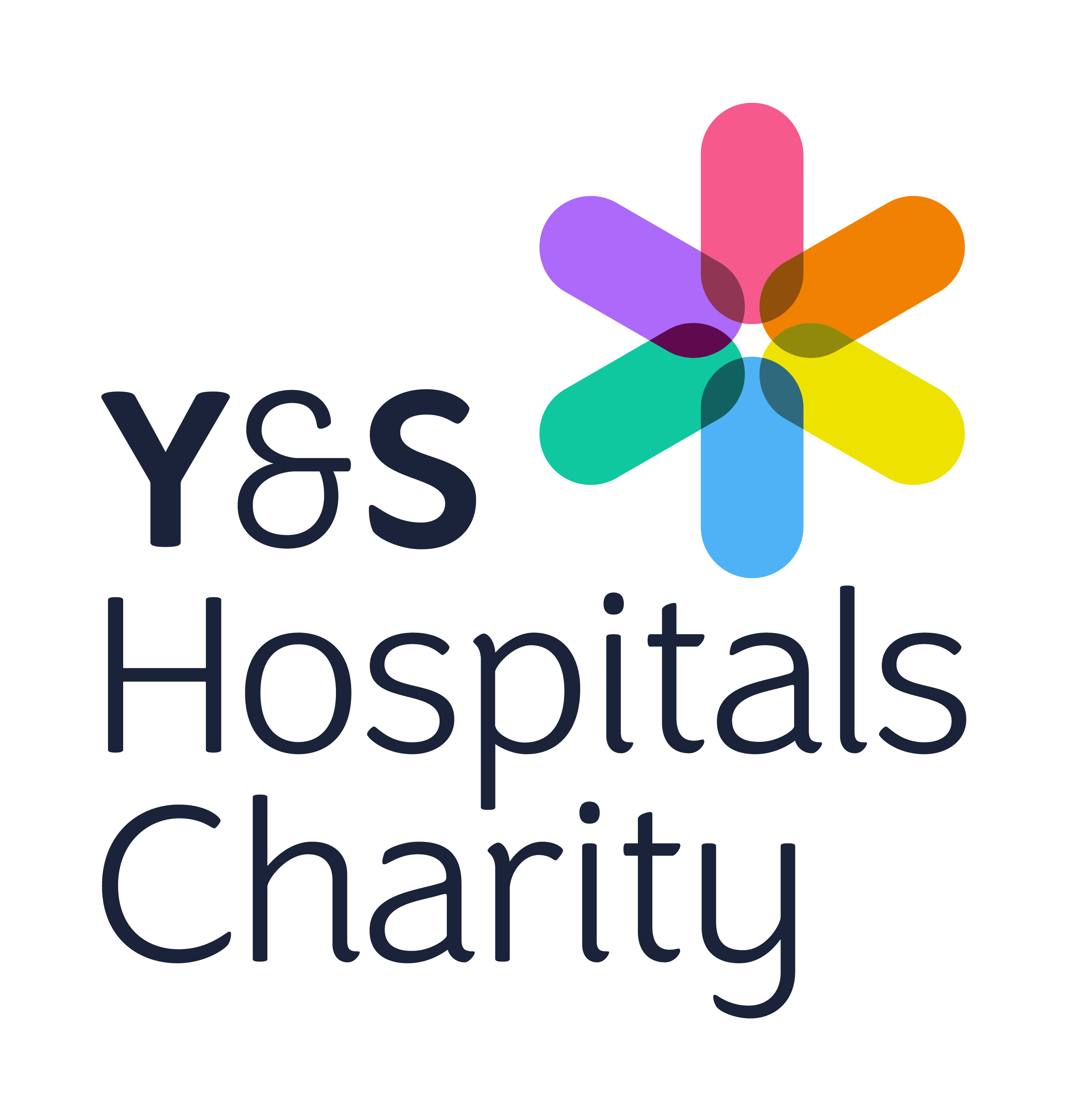In this section
Participation Arts Blog
2020
Blog: York College student documents placement on Dementia Ward Arts Project
During March/April 2020 York College student, Holly Clark, assisted artist, Sharon McDonagh, in providing weekly art sessions for patients in York Hospital's Dementia Ward. Holly documents her experience in her blog, available here.

2017
Blog: University of York students film in York Hospital's Renal Unit
During May/June 2017 students from York University worked with the Arts Team to produce a short film about participation arts in York Hospital’s Renal Unit. Some of the students have written blogs on their experience, as found below.
Review of the Mosaic Trees by Jodie Sheehan
11th July 2017
A previous blog post discussed the display of tiles in the York Hospital corridors. They were an example of more individual pieces of work since they were created independently and conveyed unique specifics about the person who created them. Another equally eye-catching display, known as the Mosaic Trees, can also be seen in the Hospital, but this one involved more collaboration from the patients. Lesley Seeger led the creation of this piece in 2012, whereby each tree was cut into small pieces for patients to work on, and these pieces were then joined together to create the final piece of work. Patients used small pieces of broken ceramics, tiles and vases, donated from various people and local businesses, and arranged them on their allocated tree fragment.
However, in order to make this work, the patients had to collaborate and ensure that each of their sections would fit together harmoniously in the final design, something which has been achieved excellently. Despite the charming finer details giving a sense of unique intricacy to each section, the trees as entireties do not look fragmented; rather, they are composed of a well-blended variety of patterns and colours in a way that appears neither repetitive nor disjointed. The colour coordination within the branches and trunk especially help to give the trees a look of unification overall. Meanwhile, we can see that many leaves and flowers have adopted the common motif of outlining their segment in one colour, and filling it in with another colour scheme. Again, while the finer details are largely individual and unique, the overall effect of the piece is one of harmony and union. An observer would be hard-pushed to tell from a distance that this artwork was not created by a single pair of hands, which pays homage to the excellent levels of communication and interaction between the patients during the formation of the Mosaic Trees.
This collaborative aspect of the piece emphasises the social element of the Arts in Hospitals initiative. Not only do patients feel that they are making good use of their time on dialysis by spending it creatively and productively, but they are also more able to interact with other patients, equipped with a common interest and common goal. This means the so-often lonely experience of being attached to an unfeeling machine is eased slightly; patients can escape their isolation by entering into conversations and building friendships. They are able to forget the machine and focus on something beautiful.
Review of the Renal tiles by Jodie Sheehan
7th July 2017
The Arts in Hospitals pieces created by dialysis patients are not only significant during the production of the art, but they also have very important after effects. Many of the pieces are displayed on the walls in the hospital corridors, creating a gallery of creativity and colour for everyone who walks among them, including the patients themselves. For them, seeing their finished artwork will remind them of what they have accomplished artistically, and what they can continue to accomplish, endowing them with feelings of pride when they come into the hospital, rather than a disheartening sense that their immense stretches of time on dialysis will be wasted. For other viewers, the artwork is a cheerful enrichment to a day at a sometimes-cheerless place.
In one corridor of York Hospital, there is a vast collection of tiles arranged in a sweeping rectangle across the wall. Upon closer inspection, each tile is detailed with a unique and intricate painting, produced by patients of the renal unit. Every tile is individual and tells a story about the person who painted it. Many of the pieces are quite abstract, depicting patterns and shapes which are left to be interpreted by the onlooker, providing an ambiguous and more interesting viewing for whoever observes it. Many also contain natural, especially floral or botanical, imagery. A particular piece that caught my eye was a painting of a small cylindrical tank of goldfish positioned centrally on a circular table, surrounded by foliage and flora. The artist has managed to capture myriad subtle reflections and refractions in the glass tank, as well as a delicate reflection of the goldfish atop the water, and soft shadows on the table. The overall effect is one of depth and dimension, as well as a sort of calm vitality. The fish appear to be moving, floating in a constant but serene motion. Their bright orange colour and central positioning pierces through the painting, drawing the viewer’s eye to the middle in order to emphasise the importance of movement and serenity in the painting.
Overall, what struck me most about the collection of tiles was the vibrancy. These lively, high-spirited paintings contrast so strongly with the perception of the experience of dialysis – the dreariness, the boredom, the drawn out expanses of time. These paintings demonstrate how active the patients’ minds are kept by doing art, despite their restricted bodies.

Master classes by Millie Dellamuro
20th June 2017
We had three master classes to help with the progress of our film and teach us skills and information relevant to the film making process. The first master class, pre-production training, was aimed at teaching us filming skills, the second, shooting and production guidance, at filming techniques and the third, hands on help with editing, formatting the video after filming. These were all useful as before we had minimal knowledge about these areas.
The most useful thing I learnt during the first master class was interviewing techniques as before I had never realised how much thought goes into the interviewing process including what questions to ask as well as the different ways that interviewing can be done and what effect this has on the different types of film produced. For example, a lot of the interview technique depends on what the film is being created for and the target audience of the video. From this master class we realised that it would be best to interview the patients with the interviewer off screen and have the interviewee including the question within their answer so you do not hear the question asked within the video, this also helps save time as we were aware that we only had a length of two minutes for the video. However, we realised that when interviewing Van it would be best for him to address the camera, as if he is introducing the film, this works better in this instance because Van tells us about the project and his role within it.
The second master class was more about the technical aspects of using a camera and filming angles etc. This helped introduce the topic but we were also lucky to have Tim help us with the filming and he gave us helpful advice on the best way to set up interviews and shots of the artwork.
The last master class was on the editing of the video. Although we did not manage to get to this part of the process because of timing restrictions, it was still helpful and we learnt a lot that we could possibly use in future projects. It was especially interesting to learn how to use video editing software to put together a video; this included cutting footage to the right length, incorporating sound such as background music into the video, and organising different clips in an order that works best for the most effective video. This workshop also gave us the chance to have a go at editing some footage to see what kind of techniques we could use.
Creating the story board by Jessica
15th June 2017
When creating the storyboard for the evaluation film, we wanted to ensure that we planned effectively given that final piece would be just two minutes long. The team and I decided that in this short space of time, it was essential to capture the following: how the art makes patients feel, the positive impact art brings, Van’s projects and the creative displays around the hospital itself. By capturing this, we hope the final clip will provide our clients and observers with an immersive experience and understanding of a very worthwhile project.
The first scenes in the storyboard help to contextualise the project. The upbeat music we plan to open the film will hopefully reflect the positive and constructive impact art has upon the patients. This compliments the panning shot of the art work on the hospital corridor walls. By focusing on the artwork in this medical environment, the project promotes the idea that the hospital are their own space, and that they do not have to be a white-washed, clinical spaces. As a result, this will provide the viewer with a new perspective from what hospitals are usually associated with.
This is particularly important when taking into account that the renal patients visit the hospital for dialysis treatment many times in a week. Therefore, art work makes this familiar environment appear more homely and comforting- giving their space personality.
The main body of the storyboard will consist of two interviews we plan to arrange with patients. Within these personal insights to the project, we want out film to show how art is for all, not just those with existing interest. As a result, we hope that the questions we pose to the patients will capture the worthiness of Van’s work. Especially how it works around an individual patients interest in art, showing how there art can be for everyone. Within the voiceover scenes of the patients, we will include close up shots of hands busy at work, and different patients experimenting with different medias. As well, we hope to present the hospital as a warm and accommodating environment therefore we have planned to film on a sunny day, and have finished the story boards with a close up shot of a smiling patient.
The creation of the storyboard was an exciting stage of the project for everyone as it allowed us to document our creativity and innovation for making this film as effective as possible.
Getting Started by Jodie Sheehan
27th May 2017
Upon discovering that my application for the Arts in Hospitals Evaluation Film for the NHS project had been successful, I was very keen to get started. After an initial meeting to get to know my fellow team members and facilitator, we arranged to meet the client as soon as possible. This first meeting was at York hospital itself. We were received with a warm welcome from our client, Griselda Goldsbrough, and the artist, Van Nong, and we proceeded to discuss what the project would entail in more detail; we were to make an evaluative film reviewing patient responses to art projects in York Hospital Renal Unit in order to articulate the impact of the dialysis patients’ participation in these activities.
After we had discussed our client’s preferences regarding the nature of the video, Van helped us to understand exactly how we would be benefitting the hospital. First he showed us a selection of the artwork that dialysis patients had created. We were all extremely impressed by the high standards of the art work, especially considering, as Van informed us, many of the patients had never participated in art before. This really hit home for me, as it was a strong indication of the huge expanses of time these patients had to work on and perfect their artistic skills, as a result of the necessarily prolonged time spent on dialysis. The vast age range of the artists also struck me; there were pieces by people as young as 16, right through to the elderly. Kidney failure seemed cruelly indiscriminate. Yet looking at the art work, it was impossible to feel negative; the beautiful pieces of work demonstrated not only well-nurtured talent, but many of the collaborative pieces really brought across the harmonious social aspect of the art – patients had worked together to create these pieces and in the process, made their time on dialysis a little more bearable, together. This was something we are keen to get across in our film.
After we viewed the patients’ art, Van took us in pairs to see the Renal Unit first hand. It was challenging meeting some of the patients and being confronted with the reality of life with kidney failure. What impressed upon me most was the sheer exhaustion of the patients. Despite this, patients made the effort to talk amiably with Van; the special friendship between Van and the patients was apparent from the moment they began chatting. He was clearly a very welcome presence in the ward, which reflects how important the artwork is to the patients. Van then showed us his art supplies. For a simple trolley containing a modest number of paintbrushes, paints and pencils, it was an indispensable cornucopia of equipment. It was incredible to think that this simple trolley was what allowed so many patients to express themselves, develop artistic skills, socialise, and fundamentally, forget about dialysis.











